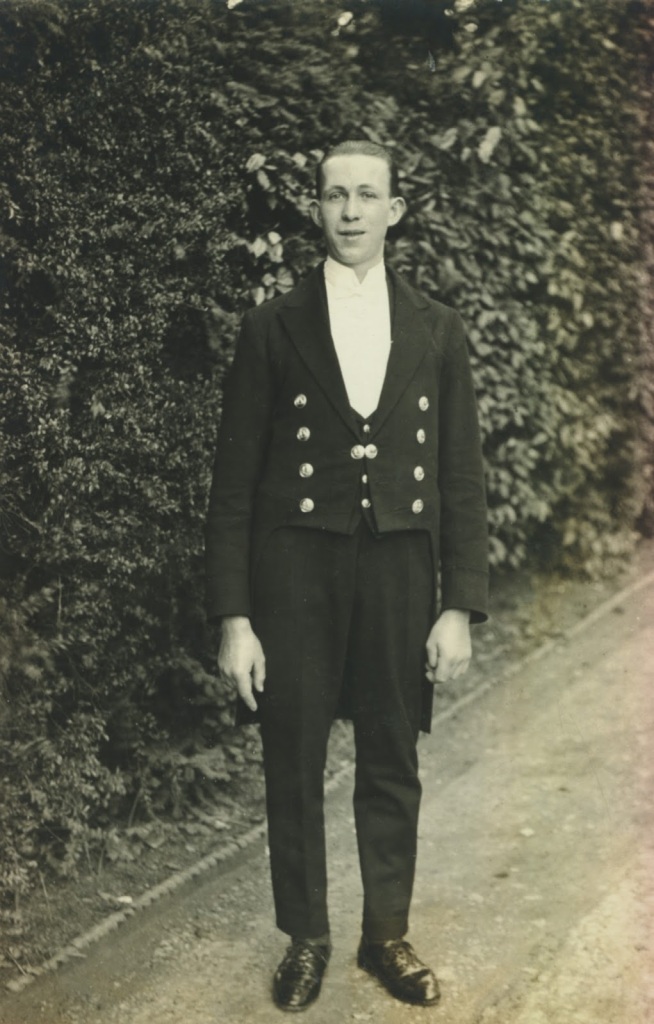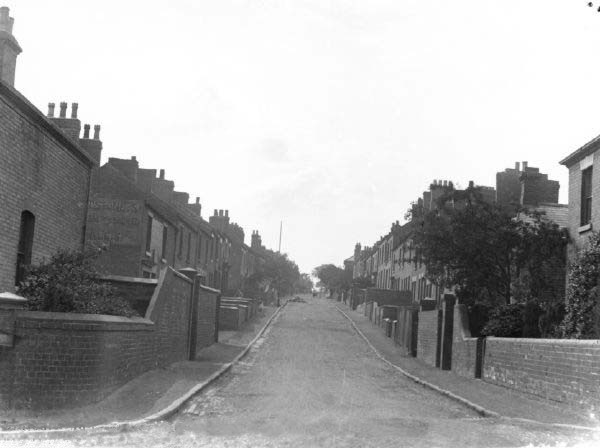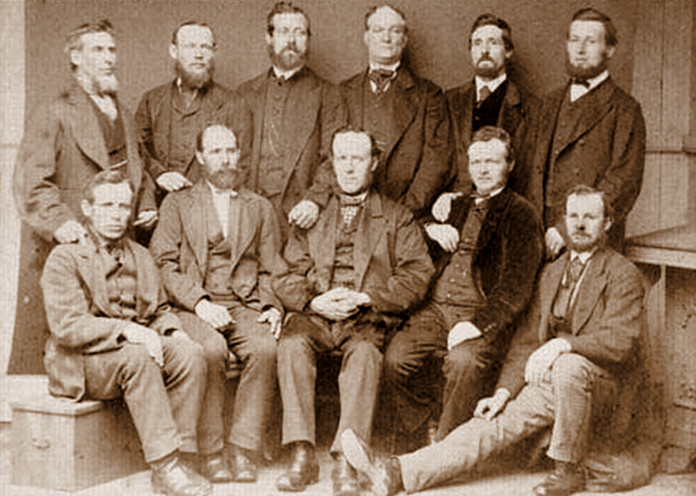This is the fourth in a series of posts about my maternal grandmother’s family, the Millses. This installment follows the lives of her grandfather George Mills and his siblings. For information on the preceding generation see Going through the Mills (part 3).
* * *
Of the five children Reuben and Charlotte Mills had between 1862 and 1877, only three are known to have survived into adulthood. Their two daughters Ellen (b. c. 1865, Codnor, Derbyshire) and Elizabeth (b. c. 1870, Codnor, Derbyshire) appear on just one census each (1871 and 1881 respectively) suggesting they both died in childhood. Their second son however, William H. Mills (b. c. November 1866, Codnor, Derbyshire), appears in every census between 1871 and 1911, meaning we can say rather more about his life.
Aged fifteen William was recorded working as a farm servant at Ratcliffe-on-Soar in Nottinghamshire, the same occupation his father held as a young man. A report in The Grantham Journal however reveals that by 1888 William had moved to Saxby in Leicestershire, where he was employed as a cowman by a farmer named Mr. Rose (12 May 1888, p. 8, col. 8). The report in question was from the Melton Mowbray petty sessions, and recounted an incident where William was accused of stealing “two fronts and collars, and one shirt, valued 4 d, the property of John Ashwell, farm pupil” of the same household. During the trial it was argued there was no direct evidence of William’s guilt, and that there were in fact several others in the house who could have taken the items. In addition his parents Reuben and Charlotte said he “had been out to service eleven years, and had never been discharged from a situation…had always borne a good character and was a dutiful son”. Despite these protestations he was found guilty, fined “£1 and costs, or fourteen days’ imprisonment with hard labour”.
Whatever the truth behind the accusations, it is unsurprising to find that by the following census in 1891 William was recorded living back at home with his parents in Kegworth, Leicestershire, where he had taken on the slightly less prestigious role of an ‘agricultural labourer.’ By this time he also appears to have met and married his wife Elizabeth, but so far no marriage record has been uncovered and her original surname remains unknown. Ten years later, with his life seemingly back on track, the 1901 census shows William employed as a ‘stockman’ (cattle specialist) on a farm in Toton near Nottingham, where he and Elizabeth were living with their five children. By his final census appearance in 1911 however, he was back living in Kegworth and working as a plumber. The reasons for this rather abrupt career change in his forties may never be discerned but regardless, this is the final identifiable appearance of William in the historical record.
William’s younger brother John Thomas Mills (b. c. October 1877, Underwood, Nottinghamshire), Reuben and Charlotte’s youngest son, begun his working life as a ‘rod buffer’ in Kegworth according to the 1891 census. Quite what this occupation entailed is unclear, however it may have had something related to agricultural drainage. By 1901 however, John Thomas had found employment as a footman in the service of the wealthy Lancashire quarry and colliery owner William Brooks, Second Baron Crawshaw of Crawshaw Hall. As the household’s only footman he would have reported directly to the butler, and his work would have involved a mix of domestic duties such as waiting at table, attending the door, cleaning silver, and perhaps acting as a valet. A good contemporary description of a footman’s daily routine can be found in Mrs Beeton’sThe Book of Household Management(Beeton, 1907, 1764-1766).

Valued highly as status symbols in the Victorian and Edwardian eras, footmen were often tall, good looking and athletic young men whose function was as ornamental as it was practical. Perhaps because of this, footmen were sometimes denied the respect they deserved. The master of the house would typically call all footmen by a generic name (e.g. ‘William’) to avoid having to learn a new name each time a man was hired. In addition, by the early 1900s domestic service was beginning to be seen as a somewhat ‘unmanly’ occupation due to the growing number of female household servants in the late Nineteenth Century (Lethbridge, 2013, 46-47). Despite this social stigma John Thomas continued working as a footman until at least 1911, when at the age of thirty four he was recorded living back in Kegworth in the employ of a local clergyman named Henry Major Stephenson.


By the time he was thirty eight however, there is evidence John Thomas had left domestic service and had begun working as a labourer in Derby, where he lived at 97 Shaftesbury Crescent. This evidence comes from his army service record, which tells us that on 19 November 1915 he had enlisted as a private in the 16th Battalion of the York and Lancaster Regiment. The timing is especially poignant given that his mother Charlotte had died the previous day in Kegworth Union Workhouse, and his father Reuben, who he gave as his next-of-kin, would also be gone within four days.
His service record also attests that he was 5’5 1/2″ tall (average for the time, but relatively short for a footman), and that he had initially been relegated to the army reserve. On 19 March 1917 however he was mobilised and a week later was posted to Beaumarais in south-west Germany. Over next few months he was attached to a succession of different regiments, as the war’s rising death toll forced shrinking regiments to merge and reorganise. On 14 April he was transferred to the 25th Battalion of the Durham Light Infantry (7th Labour Battalion), then on 30 April to the 4th Battalion of the Lincolnshire Regiment (L Company), and then the Labour Corps on 14 May. A few days later, on 25 May he returned to his original regiment, the 16th (transport workers) Battalion of the York and Lancaster Regiment, and on 16 June was transferred one last time to the 1st Battalion of the Nottinghamshire and Derbyshire Regiment.
The number and type of regiments to which John Thomas was assigned suggests he may have served mostly in non-combatant roles, providing labour to build and maintain the army’s transport and communications infrastructure when and wherever this was required. These roles, typically filled by older or less physically able recruits like John Thomas, were not without risks however. On 31 January 1918 he was diagnosed with ‘myalgia’, a form of chronic muscle pain, and was evacuated to England a few days later. According to his army pension record, his condition was attributed to his service, which entitled him to a 20% bonus to his weekly pension (total 5s 6d). His pension record also records his last known address as 3 Trenville Avenue, Fulham Road, Sparkhill, just south of Birmingham. He appears never to have married or had any children, and it is currently unknown when or where he died.
* * *
Like his younger brothers William and John Thomas, my great-great-grandfather George Mills was recorded in the 1881 census living at his parents’ home in Ratcliffe-on-Soar, Nottinghamshire. As we saw in the previous post, he was born at Langar Lodge on 9 April 1862, and had moved with his parents to Codnor, then Underwood. In the 1881 census he was listed as a farm servant, but by 1884 was working as an agricultural labourer in the nearby village of Kegworth, just over the Leicestershire border. This we know from his marriage certificate, which tells us that at the age of twenty one, on 10 March that year he married a eighteen year old local dressmaker named Frances “Fanny” Hardy Oldershaw.
Born in Kegworth on 4 June 1863, Fanny’s birth certificate recorded no father, and confirms she had actually been born Frances Hardy. She would not take the name Oldershaw name until her mother, a seamstress named Millicent Hardy (b. c. 1837, Kegworth, Leicestershire), married framework knitter Joseph Oldershaw (b. c. 1833, Kegworth, Leicestershire) on Christmas Day the following year. They would go on to have at least six children together, however Joseph appears to have been a far from perfect father or husband. At age twenty he was charged with assaulting a woman named Lydia Hudson following a quarrel between two children (Leicestershire Mercury, 15 October 1853), and four years later was fined 5s. and costs (or six hours in the stocks) for being drunk and disorderly (Leicestershire Mercury, 7 November 1857). During the incident the arresting officer PC Butterworth claimed Joseph “threatened to knock his brains out with the poker”. Years later Given he was given “a school attendance order in respect of four of his children for whom he neglected to provide sufficient elementary instruction,” most likely referring to his four youngest (The Derby Mercury, 29 October 1879). There are even two accounts of him being drunk and disorderly in his sixties (Leicester Chronicle, 1 September 1894 and 6 November 1897), the latter of which notes he had been convicted on several occassions. In the 1901 census he is recorded as being in receipt of parish pay, and he and Millicent were no longer living together. Joseph died a year later, and Millicent followed six years later on 18 December 1908.
A chaotic home life and an unpredictable step-father could partly explain why Fanny and George chose to get married in Langar, George’s Nottinghamshire birthplace, even though they were both living in Kegworth at the time. It was also likely chosen because it was a discreet distance away from both Fanny and George’s families. As Fanny was under twenty one at the time the couple would have required her parents’ permission to marry, and perhaps this was an attempt to get around that.
Is it possible to guess why her parents may have refused to support the marriage? A birth certificate for a girl named Minnie Hardy Oldershaw registered the previous year may provide a clue. This certificate confirms that on 12 July 1883 Fanny had given birth to a baby girl in Kegworth, eight months before her marriage to George. Perhaps when her pregnancy became public knowledge her parents shunned her and refused to have anything to do with the baby? As Fanny was unmarried at the time, no father’s name was recorded on her daughter’s birth certificate, but when Minnie sadly passed away from measles and capillary bronchitis on 25 November 1886 her father was named as ‘George Oldershaw’. This appears to be a false name given by George Mills, the informant, in an attempt to pass off Minnie as his legitimate daughter. Whether or not he had also been her biological father all along we can only speculate.
Tragedy was to strike the family twice in late 1886, for not only did they lose Minnie but also their second daughter, one-year-old Ellen Elizabeth Mills. Ellen’s cause of death has not yet been ascertained but it seems plausible she could have been carried off by the same measles outbreak which took her older sister. George and Fanny’s third child John George “Jack” Mills would have been just a few months old at the time, but fortunately he is known to have survived to adulthood, as did all six of his younger brothers and sisters. The Mills children were all born in Kegworth and grew up in the same family home near the hermitage at 17 Loughborough Road (later called London Road). Their names were:
- Ellen Elizabeth (b. c. February 1885, Kegworth, Leicestershire – d. c. November 1886, Kegworth, Leiecestershire)
- John George “Jack” (b. 13 November 1886, Kegworth, Leicestershire – d. 11 September 1963, Leicestershire)
- Alfred William “Fred” (b. c. February 1888, Kegworth, Leicestershire)
- Harry (b. 7 October 1889, Kegworth, Leicestershire – d. c. February 1968, Heanor, Derbyshire)
- Edith Ellen “Nell” (b. 8 February 1891, Kegworth, Leicestershire – d. 27 April 1960, 51 Holly Street, Lincoln, Lincolnshire)
- Alice (b. 12 March 1893, Kegworth, Leicestershire – d. 3 February 1961, Long Eaton, Derbyshire)
- Frances Harriet (b. 22 April 1895, Kegworth, Leicestershire – d. c. February 1982, Ilkeston, Derbyshire)
- Elizabeth Ann “Lizzie” (b. 9 December 1899, Kegworth, Leicestershire – d. 8 January 1979, Bilborough, Nottinghamshire)
The two photographs below from around 1888 and 1894 show Fanny with some of her and George’s children. In the first, she is shown with Jack and Fred in black clothing, which could have been mourning attire for her daughters Minnie and Ellen. Rather poignantly, the dresses her sons are shown wearing had probably belonged to their older sisters before being handed down to them (the tradition of dressing of young boys in dresses had always been one borne of economic necessity, rather than a conscious fashion choice). It is a posed, studio photograph, perhaps taken to commemorate Fred’s christening. The second more informal photograph was probably taken outside the family home and shows her with Jack, Nell, Alice, Fred, and my great-grandfather Harry Mills.


Throughout the 1880s and 1890s George had continued supporting the family working as an agricultural labourer, but by 1901 he had found employment at a plaster and cement mill works, most likely the one owned by the Winser family which stood over the river at the bottom of Mill Lane. The map below shows its location on the eastern edge of the village, as well as the Millses’ home on London Road to the south.

By 1911 George was once again working as a farm labourer. At around this time, according to one of his descendants, he is said to have had his picture featured in a local newspaper after preventing a bank robbery. He was apparently on his way to fetch Dr. Bedford for his daughter Lizzie when he saw two men attempting to break into Westminster Bank. He quickly went off to find a policeman who lived nearby and the robbery was stopped in time. After all their children left home George and Fanny moved into in a house opposite the cinema on Derby Road, where they lived until Fanny’s death at the age of sixty seven on 26 August 1930. The official cause of death was a carcinoma of the liver, and her daughter Elizabeth was the informant.

Following his wife’s death, George moved in with his daughter Alice and her husband Thomas Alfred “Alvy” Wilmot, who are recorded living at 220 Tamworth Road, Long Eaton in the 1939 register. He remained in Long Eaton for the rest of his life, and his last known address was 16 Hawthorne Avenue. Two days before Christmas 1950, at the age of eighty eight he died in Shardlow hospital of broncho-pneumonia, cerebral thrombosis and a carcinoma of the rectum. He was buried alongside his wife Fanny in Kegworth Parish churchyard.

In the fifth and final post in this series we will look at what happened to George and Fanny’s children, before focusing specifically on my great-grandfather Harry, his wife Ruth Spencer, and my grandmother Julia Mary Mills.
Sources
Beeton, Isabella. Mrs. Beeton’s Book of household management : a guide to cookery in all branches, daily duties, mistress & servant, hostess & guest, marketing, trussing and carving, menu making, home doctor, sick nursing, the nursery, home lawyer. London: Ward, Lock & Co., 1907
Lethbridge, Lucy. Servants: A Downstairs History of Britain from the Nineteenth Century to Modern Times. New York: W.W. Norton & Company, 2013.










